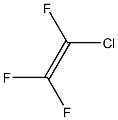Chlorotrifluoroethylene
- CAS NO.:79-38-9
- Empirical Formula: C2ClF3
- Molecular Weight: 116.47
- MDL number: MFCD00000822
- EINECS: 201-201-8
- SAFETY DATA SHEET (SDS)
- Update Date: 2024-12-18 14:08:52

What is Chlorotrifluoroethylene?
Chemical properties
Colorless gas; faint ethereal odor. Decomposes in water.
The Uses of Chlorotrifluoroethylene
Intermediate, monomer for chlorotrifluoroethylene resins.
Preparation
Chlorotrifluoroethylene is prepared from ethylene by the following route:

Ethylene is treated with an excess of chlorine at 300-350??C in the presence of activated charcoal to give hexachloroethane. This product is then treated with hydrogen fluoride in the presence of antimony pentachloride to yield trichlorotrifluoroethane. Dechlorination in the liquid phase with zinc dust and ethanol results in the formation of chlorotrifluoroethylene which is washed with water to remove alcohol, dried and distilled under pressure.
Synthesis Reference(s)
The Journal of Organic Chemistry, 57, p. 5018, 1992 DOI: 10.1021/jo00044a044
General Description
Chlorotrifluoroethylene is a colorless gas with a faint ethereal odor. Chlorotrifluoroethylene is shipped as a liquefied gas under its vapor pressure. Chlorotrifluoroethylene is very toxic by inhalation and is easily ignited. The vapors are heavier than air and a flame can flash back to the source of leak very easily. This leak can either be a liquid or vapor leak. The vapors can asphyxiate by the displacement of air. Contact with the liquid can cause frostbite. Under prolonged exposure to intense heat or fire the containers may violently rupture and rocket, or the material may polymerize with possible container rupture.
Air & Water Reactions
Highly flammable.
Reactivity Profile
Halogenated aliphatic compounds, such as Chlorotrifluoroethylene, are moderately or very reactive. Reactivity generally decreases with increased degree of substitution of halogen for hydrogen atoms. Low molecular weight haloalkanes are highly flammable and can react with some metals to form dangerous products. Materials in this group are incompatible with strong oxidizing and reducing agents. Also, they are incompatible with many amines; nitrides; azo/diazo compounds; alkali metals; strong oxidizers such as chlorine perchlorate, oxygen, bromine; and epoxides.
Hazard
Dangerous fire risk. Flammable limits in air 8.4–38.7%.
Health Hazard
Inhalation causes dizziness, nausea, vomiting; liver and kidney injury may develop after several hours and cause jaundice and necrosis of the kidney. Contact with liquid causes frostbite of eyes and possibly of skin.
Flammability and Explosibility
Extremely flammable
Safety Profile
Poison by ingestion and intraperitoneal routes. Moderately toxic by inhalation. Very dangerous fire hazard when exposed to heat, flames (sparks), or oxidizers. To fight fire, stop flow of gas. Violent reaction when mixed with (Brz + 02) or (CIF3 + water). Potentially explosive polymerization reaction with ethylene. Incompatible with 1,l -dchloroethylene; oxygen. When heated to decomposition it emits toxic fumes of Fand Cl-. See also CHLORINATED HYDROCARBONS, ALIPHATIC; and FLUORIDES.
Purification Methods
Scrub it with 10% KOH solution, then 10% H2SO4 solution to remove inhibitors, dry and pass it through silica gel. It is stabilized with ~1% tributylamine. Use brass equipment. [Beilstein 1 III 646.] TOXIC GAS.
Properties of Chlorotrifluoroethylene
| Melting point: | −158 °C(lit.) |
| Boiling point: | −28.4 °C(lit.) |
| Density | 1,305 g/cm3 |
| vapor density | 4.13 (vs air) |
| vapor pressure | 612kPa at 25℃ |
| refractive index | 1.3800 |
| Flash point: | -28°C |
| Water Solubility | 380mg/L at 28℃ |
| InChI | InChI=1S/C2ClF3/c3-1(4)2(5)6 |
| CAS DataBase Reference | 79-38-9(CAS DataBase Reference) |
| NIST Chemistry Reference | Ethene, chlorotrifluoro-(79-38-9) |
| EPA Substance Registry System | Chlorotrifluoroethylene (79-38-9) |
Safety information for Chlorotrifluoroethylene
| Signal word | Danger |
| Pictogram(s) |
 Flame Flammables GHS02  Skull and Crossbones Acute Toxicity GHS06 |
| GHS Hazard Statements |
H220:Flammable gases H280:Gases under pressure |
| Precautionary Statement Codes |
P210:Keep away from heat/sparks/open flames/hot surfaces. — No smoking. P261:Avoid breathing dust/fume/gas/mist/vapours/spray. P311:Call a POISON CENTER or doctor/physician. P301+P310:IF SWALLOWED: Immediately call a POISON CENTER or doctor/physician. P410+P403:Protect from sunlight. Store in a well-ventilated place. |
Computed Descriptors for Chlorotrifluoroethylene
| InChIKey | UUAGAQFQZIEFAH-UHFFFAOYSA-N |
| SMILES | C(/Cl)(\F)=C(\F)/F |
New Products
4-Fluorophenylacetic acid 4-Methylphenylacetic acid N-Boc-D-alaninol N-BOC-D/L-ALANINOL Tert-butyl bis(2-chloroethyl)carbamate 3-Morpholino-1-(4-nitrophenyl)-5,6-dihydropyridin- 2(1H)-one Furan-2,5-Dicarboxylic Acid Tropic acid S-2-CHLORO PROPIONIC ACID ETHYL ISOCYANOACETATE 2-Bromo-1,3-Bis(Dimethylamino)Trimethinium Hexafluorophosphate (6-METHYL-[1,3]DITHIOLO[4,5-b]QUINOXALIN-2-ONE INDAZOLE-3-CARBOXYLIC ACID 4-IODO BENZOIC ACID (2-Hydroxyphenyl)acetonitrile 4-Bromopyrazole 5,6-Dimethoxyindanone 2-(Cyanocyclohexyl)acetic acid 4-methoxy-3,5-dinitropyridine 2-aminopropyl benzoate hydrochloride 1-(4-(aminomethyl)benzyl)urea hydrochloride diethyl 2-(2-((tertbutoxycarbonyl)amino) ethyl)malonate tert-butyl 4- (ureidomethyl)benzylcarbamate Ethyl-2-chloro((4-methoxyphenyl)hydrazono)acetateRelated products of tetrahydrofuran








You may like
-
 2033-24-1 98%View Details
2033-24-1 98%View Details
2033-24-1 -
 42831-50-5 5-METHYLISOXAZOLE-4-CARBOXYLIC ACID 98%View Details
42831-50-5 5-METHYLISOXAZOLE-4-CARBOXYLIC ACID 98%View Details
42831-50-5 -
 1975-50-4 98%View Details
1975-50-4 98%View Details
1975-50-4 -
 2-HYDROXY BENZYL ALCOHOL 98%View Details
2-HYDROXY BENZYL ALCOHOL 98%View Details
90-01-7 -
 2-Chloro-1,3-Bis(Dimethylamino)Trimethinium Hexafluorophosphate 221615-75-4 98%View Details
2-Chloro-1,3-Bis(Dimethylamino)Trimethinium Hexafluorophosphate 221615-75-4 98%View Details
221615-75-4 -
 61397-56-6 CIS BROMO BENZOATE 98%View Details
61397-56-6 CIS BROMO BENZOATE 98%View Details
61397-56-6 -
 14714-50-2 (2-Hydroxyphenyl)acetonitrile 98+View Details
14714-50-2 (2-Hydroxyphenyl)acetonitrile 98+View Details
14714-50-2 -
 118753-70-1 98+View Details
118753-70-1 98+View Details
118753-70-1